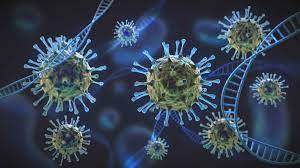Daniel Becker, an adjunct professor of biology in the University of Oklahoma’s Dodge Family College of Trades and Lores, has been leading a visionary modeling study over the last time and a half to identify club species that are likely to carry betacoronaviruses, including but not limited to SARS-suchlike contagions.
The study”Optimizing prophetic models to prioritize viral discovery in zoonotic budgets,”which was published by Lancet Microbe, was guided by Becker; Greg Albery, a postdoctoral fellow at Georgetown University’s Bansal Lab; and ColinJ. Carlson, an assistant exploration professor at Georgetown’s Center for Global Health Science and Security.
It also included collaborators from the University of Idaho, Louisiana State University, University of California Berkeley, Colorado State University, Pacific Lutheran University, Icahn School of Medicine at Mount Sinai, University of Glasgow, Université de Montréal, University of Toronto, Ghent University, University College Dublin, Cary Institute of Ecosystem Studies, and the American Museum of Natural History.
Becker and associates’ study is part of the broader sweats of an transnational exploration platoon called the Verena Consortium (viralemergence.org), which works to prognosticate which contagions could infect humans, which creatures host them, and where they could crop. Albery and Carlson wereco-founders of the institute in 2020, with Becker as a launching member.
Despite global investments in complaint surveillance, it remains delicate to identify and cover wildlife budgets of contagions that could eventually infect humans. Statistical models are decreasingly being used to prioritize which wildlife species to sample in the field, but the prognostications being generated from any one model can be largely uncertain. Scientists also infrequently track the success or failure of their prognostications after they make them, making it hard to learn and make better models in the future. Together, these limitations mean that there’s high query in which models may be stylish suited to the task.
In this study, experimenters used club hosts of betacoronaviruses, a large group of contagions that includes those responsible for SARS and COVID-19, as a case study for how to stoutly use data to compare and validate these prophetic models of likely force hosts. The study is the first to prove that machine literacy models can optimize wildlife slice for undiscovered contagions and illustrates how these models are stylish enforced through a dynamic process of vaticination, data collection, confirmation and updating.
In the first quarter of 2020, experimenters trained eight different statistical models that prognosticated which kinds of creatures could host betacoronaviruses. Over further than a time, the platoon also tracked discovery of 40 new club hosts of betacoronaviruses to validate original prognostications and stoutly modernize their models. The experimenters plant that models employing data on club ecology and elaboration performed extremely well at prognosticating new hosts of betacoronaviruses. In discrepancy, slice- edge models from network wisdom that used high- position mathematics – but lower natural data – performed roughly as well or worse than anticipated at arbitrary.
Importantly, their revised models prognosticated over 400 club species encyclopedically that could be undetected hosts of betacoronaviruses, including not only in southeast Asia but also insub-Saharan Africa and the Western Semicircle. Although 21 species of horseshoe batons (in the Rhinolophus rubric) are known to be hosts of SARS-suchlike contagions, experimenters plant at least two-fourths of presumptive betacoronavirus budgets in this club rubric might still be undetected.
“One of the most important effects our study gives us is a data- driven shortlist of which club species should be studied further,” said Becker, who adds that his platoon is now working with field biologists and galleries to put their prognostications to use.”After relating these likely hosts, the coming step is also to invest in monitoring to understand where and when betacoronaviruses are likely to unmask over.”
Becker added that although the origins of SARS-CoV-2 remain uncertain, the spillover of other contagions from batons has been started by forms of niche disturbance, similar as husbandry or urbanization.

